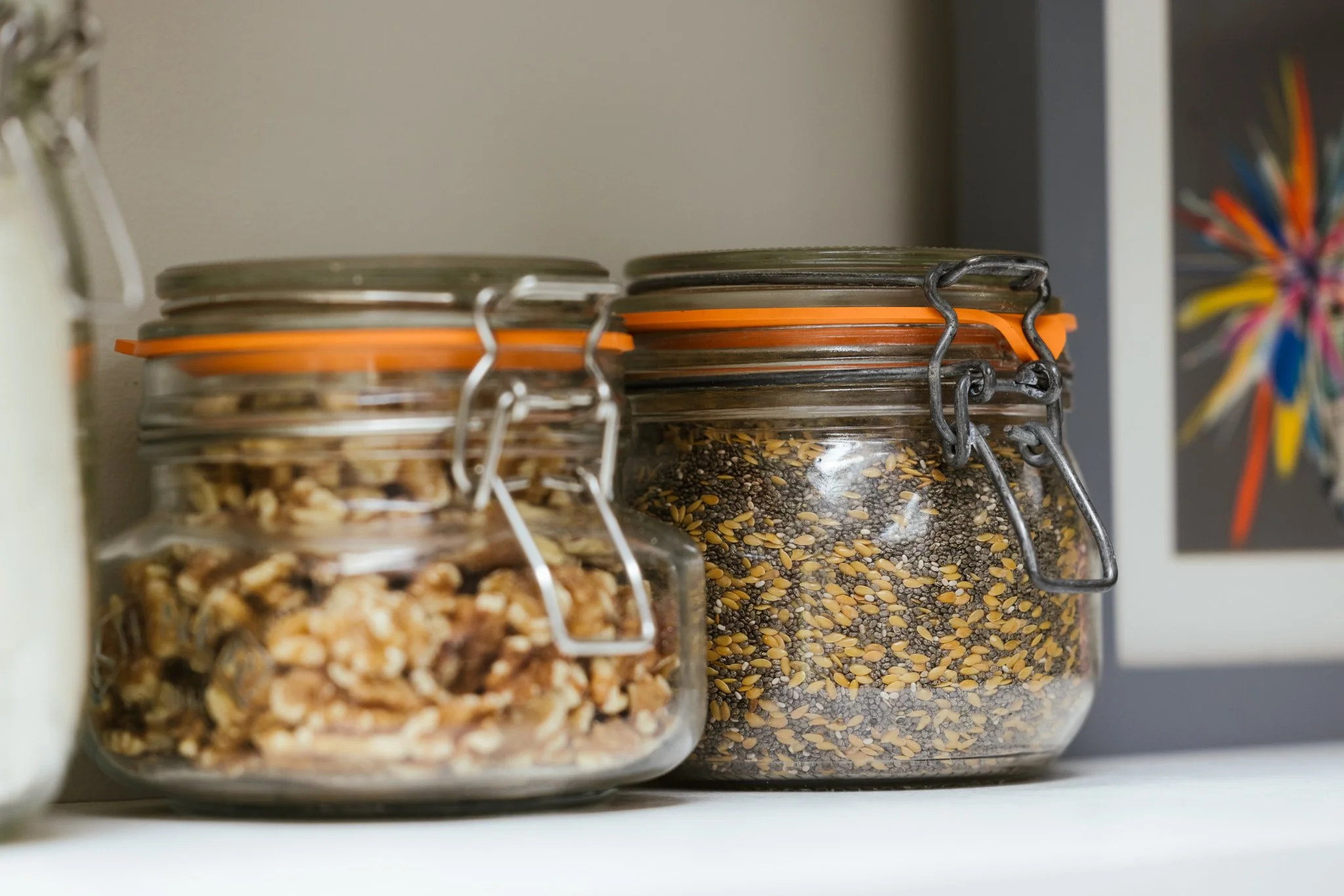Understanding Carbs: Why Fibre might be your friend
Carbohydrates can often be oversimplified, with the focus usually on quantity rather than the quality, timing, and fibre content that research increasingly shows are crucial for metabolic, hormonal, and gut health.
From a physiological perspective, carbohydrates are the body’s preferred and most efficient source of energy. Glucose, their simplest form, is essential for cellular function, particularly in the brain and muscles, which have high and constant energy demands. The brain alone accounts for roughly 20% of total daily energy expenditure.
Far from being inherently problematic, carbohydrates play a central role in maintaining metabolic flexibility, appetite regulation, and hormonal balance. For individuals experiencing symptoms such as energy fluctuations, cravings, digestive discomfort, or perimenopausal shifts, examining carbohydrate quality, rather than restricting intake, can offer a more effective and sustainable approach.
Despite their essential functions, carbohydrates are often viewed with suspicion, commonly associated with weight gain, cravings, or blood sugar spikes. Influenced by low-carb and ketogenic trends, many people have reduced their intake significantly, sometimes without recognising the longer-term impact this can have on fibre consumption, gut health, and hormonal balance.
Research shows that Bifidobacteria, a key genus of beneficial gut bacteria, tend to decline on low-carbohydrate diets. This matters: Bifidobacteria contribute to gut health by reinforcing the intestinal barrier, supporting immune function, fermenting fibre into beneficial short-chain fatty acids (SCFAs), and helping maintain microbial balance (2, 3).
Simple vs Complex: Why Structure Matters
Carbohydrates are typically classified as either simple or complex, depending on their chemical structure and how rapidly they are digested and absorbed. This distinction isn’t about “good” or “bad” carbs — it’s about their effects on blood glucose, satiety, and metabolic regulation.
Simple carbohydrates - found in sugar, fruit juice, white bread, and many ultra-processed foods- are broken down quickly. This leads to a sharp increase in blood glucose and insulin, often followed by a rapid dip in blood sugar - a cycle that can drive fatigue and further cravings.
Complex carbohydrates - present in whole grains, legumes, vegetables, berries, fruits, and nuts - consist of longer chains of sugar molecules and are digested more slowly. They tend to be richer in fibre, micronutrients, and phytochemicals, supporting more stable blood sugar levels, improved satiety, and better long-term metabolic health (1).
Understanding fibre: the key to smarter carbohydrate choices
Fibre is a defining component of many complex carbohydrates, and one of the most overlooked. Although it’s technically a carbohydrate, fibre isn’t digested by human enzymes. Instead, it feeds beneficial gut microbes, making it a critical dietary component for gut and metabolic health.
Fibre supports:
Bowel regularity, by adding bulk and moisture to the stool
Blood sugar regulation, by slowing the absorption of glucose after meals
Cholesterol balance, particularly via soluble fibre’s effects on bile acid metabolism
Hormone metabolism, by facilitating the elimination of oestrogens and other compounds via the gut
Two main types of fibre:
Soluble fibre, found in oats, apples, carrots, and legumes, dissolves in water to form a gel-like substance that slows digestion and may help lower LDL cholesterol.
Insoluble fibre, found in whole grains, nuts, seeds, and many vegetables, provides bulk and helps maintain bowel regularity.
Fibre also acts as a prebiotic, feeding bacteria that ferment it into short-chain fatty acids such as butyrate, acetate, and propionate. These compounds help strengthen the gut lining, regulate immune responses, and influence metabolic and even cognitive function through the gut-brain axis (4).
Despite these wide-ranging benefits, fibre intake remains low in the UK. While the recommended minimum is 30g per day, the average intake is just 18g. *Gradually increasing foods like oats, quinoa, lentils, broccoli, and flaxseeds can help bridge this gap, improving digestion, supporting blood sugar control, and enhancing hormone clearance via the gut-liver axis.
*If you haven't been eating sufficient fibre, it is important to increase slowly to reduce the risk of digestive discomfort.
Carbohydrates, Fibre and Hormone Health
Fibre plays an important role in hormone balance, particularly for oestrogen. After oestrogen has done its job, it’s processed in the liver and excreted via the gut. If bowel movements are sluggish or fibre intake is low, some oestrogen can be reabsorbed, which may contribute to symptoms of hormonal imbalance.
These symptoms may vary depending on life stage. In the premenstrual phase, they might include bloating, breast tenderness, or mood swings. During perimenopause, fluctuating hormones can lead to irritability, heavier or irregular periods, and disrupted sleep. Post-menopause, when oestrogen levels are consistently lower, women may experience vaginal dryness, joint stiffness, or lower mood. A fibre-rich diet with plenty of plant diversity can support hormone clearance, promote regular bowel movements, and help smooth out energy and mood fluctuations (5,6).
Blood sugar stability may also become more important during perimenopause and beyond. Oestrogen is understood to enhance insulin sensitivity, so as levels decline, the risk of insulin resistance may rise. Insulin resistance means cells in the muscles, liver, and fat become less responsive to insulin, the hormone that moves glucose from the bloodstream into cells. The body may compensate by producing more insulin, which over time can contribute to fatigue, increased fat storage around the middle, and low-grade inflammation - all of which may further affect insulin sensitivity and potentially create a vicious cycle (7,8). Choosing carbohydrates that are high in fibre, such as whole grains, legumes, and vegetables, may help support insulin function, reduce cravings, and promote more consistent energy throughout the day.
Cravings, Energy and the Glycaemic Curve
If you’ve ever felt foggy or flat after a bowl of cereal, or found yourself reaching for snacks not long after lunch, it could be down to the type and timing of your carbohydrates. Highly refined carbs, like white bread or sugary snacks, are digested quickly. They cause a rapid spike in blood sugar, followed by a crash as insulin sweeps the glucose out of your bloodstream. This rollercoaster effect can leave you tired, irritable, or craving more sugar soon after. Over time, frequent spikes can also make it harder for your body to respond to insulin efficiently, which may increase the risk of insulin resistance. Including slow-release carbs alongside protein and healthy fats helps buffer this effect. These foods are digested more gradually, leading to a slower, steadier rise in blood glucose, a flatter curve, which supports clearer thinking, more stable energy, and longer-lasting fullness. Carbohydrate timing also matters. Starting the day with a protein-rich breakfast that includes fibre and slow-digesting carbs, such as oats with nuts, seeds, Greek yoghurt and berries, or eggs with avocado and rye toast, can help curb cravings later on (9). In the evening, pairing complex carbs with protein and healthy fats may also promote satiety and support restful sleep.
So, How Many Carbs Should I Eat?
There’s no single answer; your carb needs will depend on your age, activity level, metabolism, and health. e.g. people with type 2 diabetes will have to monitor the type and amount of carbohydrates in their diet more carefully than those without the condition. Some people feel better on lower-carb approaches, especially when managing blood sugar or appetite. But for others, particularly women in midlife, very low-carb diets can backfire, increasing stress hormones or affecting mood and sleep.
Rather than counting grams, try focusing on the quality of your carbs. Aim for slow-digesting, fibre-rich options like:
Vegetables: carrots, kale, beetroot, squash, broccoli, green peas, leafy greens
Whole grains: oats, brown rice, quinoa, barley
Legumes: lentils, chickpeas, beans
Fruits: berries, apples, kiwi, citrus, pomegranate, avocado
Nuts/seeds: all add fibre, protein, and essential micronutrients
These foods not only provide energy, but also deliver fibre, vitamins, and minerals that support hormone regulation, gut health, and blood sugar balance.
Carbs and Weight
Low-carb diets can bring quick results, but this may reflect water loss and reduced glycogen stores rather than fat reduction. In the long run, balanced carb intake, especially from whole, fibre-rich sources, can support weight management by improving satiety, blood sugar stability, and metabolic health.
Research shows that when calories are matched, low-carb diets are no more effective for long-term weight loss than low-fat diets. What matters most is overall diet quality, sustainability, and an appropriate caloric reduction, not cutting out entire food groups (10).
Also, if you cut carbs too aggressively, you may end up cutting fibre too. That can affect gut health, hormone clearance, and digestion. It may also limit your intake of key nutrients like B vitamins, magnesium, potassium, and polyphenols found in plant-based carbs.
Rather than fearing carbs, think about upgrading them. Simple swaps make a big difference:
Swap white rice for quinoa or pearl barley
Choose whole or jumbo oats over instant porridge
Add lentils or beans to soups and salads
Roast sweet potato or beetroot rather than white potatoes, which are mostly starch and quickly broken down into glucose
These tweaks aren’t just about blood sugar - they support your gut, hormones, mood, and metabolism. Carbohydrates aren’t the enemy; they’re fuel. It’s all about the upgrade: choosing healthy, high fibre carbs and eating them in ways that work with your body, not against it.
Disclaimer
Content shared by Jane Lawson is for informational purposes only and is not intended to diagnose, treat, cure, or prevent any medical condition. Always consult your GP or a qualified healthcare professional with any medical concerns, and before making changes to your diet, exercise routine, or overall health plan.
References
Jaagura M, Viiard E, Karu-Lavits K, Adamberg K. Low-carbohydrate high-fat weight reduction diet induces changes in human gut microbiota. Microbiologyopen. 2021 Jun;10(3):e1194. doi: 10.1002/mbo3.1194. PMID: 34180599; PMCID: PMC8123914.
Li L, Zhao X, Abdugheni R, Yu F, Zhao Y, Ma BF, Yang Z, Li R, Li Y, Maimaitiyiming Y, Maimaiti M. Gut microbiota changes associated with low-carbohydrate diet intervention for obesity. Open Life Sci. 2024 Jan 27;19(1):20220803. doi: 10.1515/biol-2022-0803. PMID: 38299011; PMCID: PMC10828666.
Tan JK, Macia L, Mackay CR. Dietary fiber and SCFAs in the regulation of mucosal immunity. J Allergy Clin Immunol. 2023 Feb;151(2):361-370. doi: 10.1016/j.jaci.2022.11.007. Epub 2022 Dec 19. PMID: 36543697.
Xiao K, Furutani A, Sasaki H, Takahashi M, Shibata S. Effect of a High Protein Diet at Breakfast on Postprandial Glucose Level at Dinner Time in Healthy Adults. Nutrients. 2022 Dec 24;15(1):85. doi: 10.3390/nu15010085. PMID: 36615743; PMCID: PMC9824806.
Gardner CD, Trepanowski JF, Del Gobbo LC, Hauser ME, Rigdon J, Ioannidis JPA, Desai M, King AC. Effect of Low-Fat vs Low-Carbohydrate Diet on 12-Month Weight Loss in Overweight Adults and the Association With Genotype Pattern or Insulin Secretion: The DIETFITS Randomized Clinical Trial. JAMA. 2018 Feb 20;319(7):667-679






